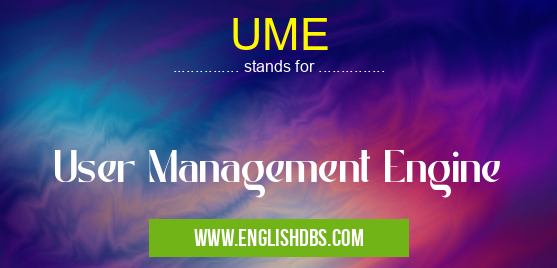What does UME mean in MANAGEMENT
UME stands for User Management Engine. It is a service which provides user authentication, access control, and resource management to businesses. UME acts as the single point of contact when authenticating new users or modifying user credentials and privileges across multiple system components in an enterprise. UME enables organizations to quickly manage user access and identity on an enterprise level, thereby helping them to secure their business resources.

UME meaning in Management in Business
UME mostly used in an acronym Management in Category Business that means User Management Engine
Shorthand: UME,
Full Form: User Management Engine
For more information of "User Management Engine", see the section below.
» Business » Management
User Authentication
User authentication is an important element of UME as it verifies the user’s identity and allows them access to a particular system or application. The authentication process typically involves verifying the user’s identity using unique identifiers such as usernames, passwords, biometric data, or even one-time codes sent via email or SMS. These identifiers are stored in UME's secure repository, ensuring a high level of security for the organization's data and systems.
Access Control
Once a user has been authenticated by UME, they can be granted varying levels of access rights and privileges to different applications and resources within the organization's system infrastructure. This helps ensure that only authorized personnel have access to sensitive information or resources. Furthermore, using UME an organization can easily monitor user behavior across all its systems enabling it to detect unauthorized activities and protect its assets from external threats.
Resource Management
UME also helps organizations manage their IT resources including compute infrastructure like servers, storage devices, network appliances etc… By utilizing UME’s resource management features organizations will be able to assign roles and permissions on individual resources based on the type of tasks they are performing ensuring that only authorized users have access to vital company information or services at any given time. This makes it easier for organizations to maintain compliance with applicable laws such as GDPR as well as industry best practices while securely managing their IT environment.
Essential Questions and Answers on User Management Engine in "BUSINESS»MANAGEMENT"
What is User Management Engine?
User Management Engine (UME) is a software application that is designed to manage user accounts, groups, and other related user information. It also provides additional functionality for authentication, authorization, auditing, and more. UME enables organizations to securely maintain user accounts and access privileges across multiple systems.
What are the benefits of using UME?
UME provides numerous benefits for organizations managing user accounts. It simplifies the process of creating and managing complex user roles and permissions. It also helps to ensure compliance with regulatory requirements by providing comprehensive auditing capabilities. Additionally, UME enables organizations to easily integrate with other applications such as Active Directory Federation Services (ADFS).
How secure is UME?
UME ensures secure user account management through multiple security controls such as strong encryption algorithms, authentication via two-factor methods, and logging events for audit purposes. Additionally, UME integrates with enterprise directory services, allowing it to be integrated into an organization’s existing security structures and processes for increased protection against unauthorized access attempts.
Does UME support single sign-on (SSO)?
Yes, UME supports SSO capabilities through integration with third-party identity providers such as Microsoft Active Directory Federation Services (ADFS). This allows users to log in only once to gain access to multiple applications within the organization without having to enter separate credentials each time.
Does UME have any features for role-based access control (RBAC)?
Yes, UME includes features designed specifically for RBAC tasks such as assigning roles to users based on their job function or enabling different levels of permission based on user profiles or group memberships within the system. This makes it easier for an organization to accurately manage user access privileges across multiple systems quickly and efficiently.
What platforms does UME support?
UME can be deployed on both physical servers as well as virtualized environments such as VMware vSphere or Microsoft Hyper-V supported implementations. It also has support for Linux and Windows operating systems including Windows Server 2016/2019/2021 Core Edition or Datacenter Edition.
Does UME require any additional hardware or software components?
No additional hardware is necessary when deploying a typical installation of UME; however some additional software components may be required depending on what type of environment you are working in (such as Active Directory). A server running one of the supported operating systems should provide all necessary components needed in order to deploy the application successfully.
What languages does the User Management Engine support?
The current version of User Management Engine supports English and Japanese languages at this time; however future versions may add support for additional languages depending on customer demand or after further research into language use patterns within different markets around the world.
Is there any documentation available regarding how to install/configure User Management Engine?
Yes – detailed installation guides along with configuration instructions are provided both online and accompanying each download package from our website so that customers can get up-and-running quickly when setting up their system according to their specific needs. Additionally our technical team is available 24/7 should customers need further support during this process.
Final Words:
In summary, User Management Engine (UME) is a powerful tool which allows businesses to securely manage authentication, access control and resource management within their networks ensuring that only authorized personnel can gain access to sensitive information or systems within the enterprise while maintaining regulatory compliance. Using UME businesses are also able to keep track of user activity allowing them identify any potential malicious behavior within their IT environment before any serious damage can occur.
